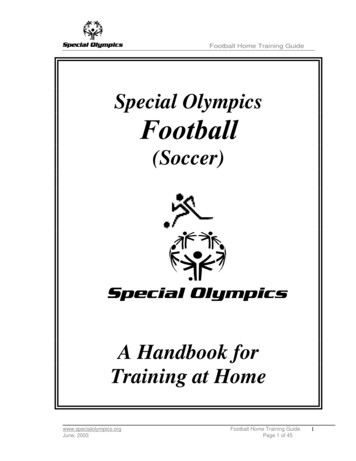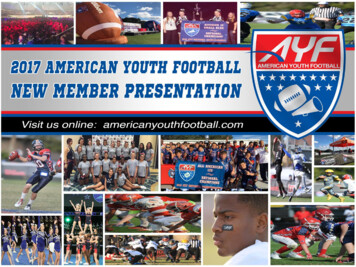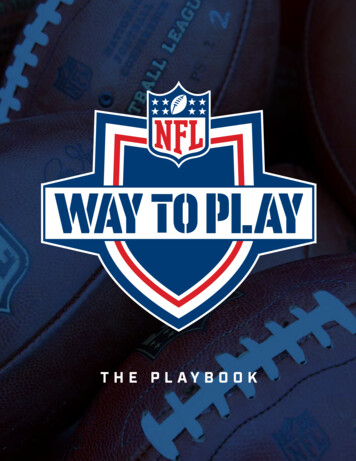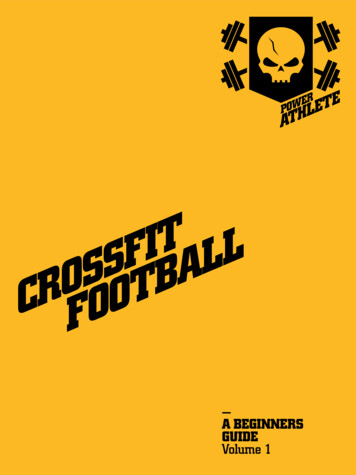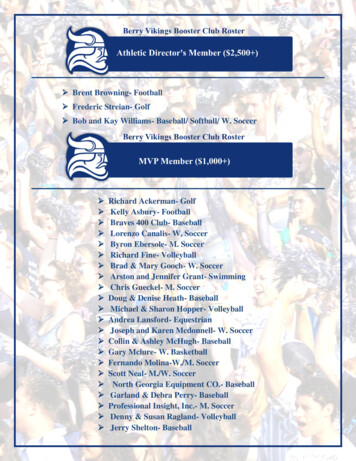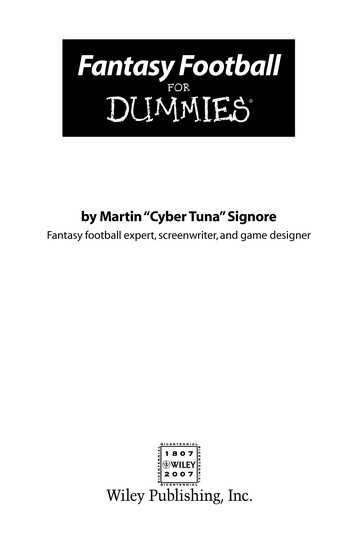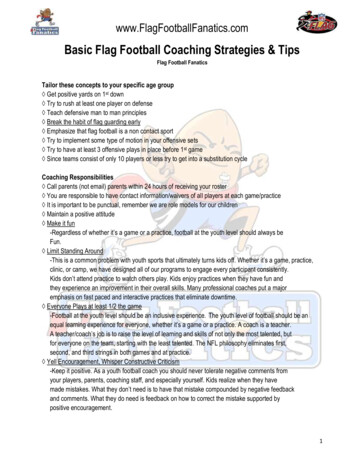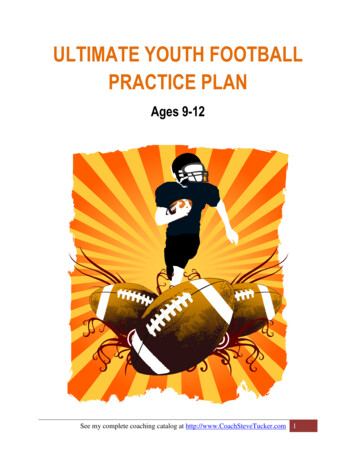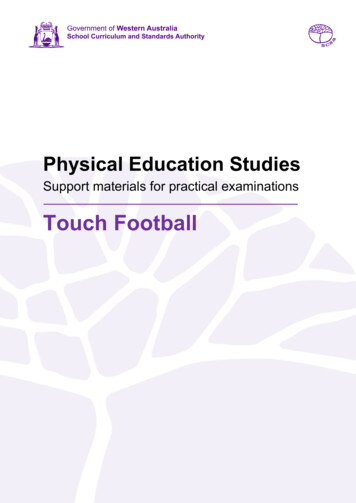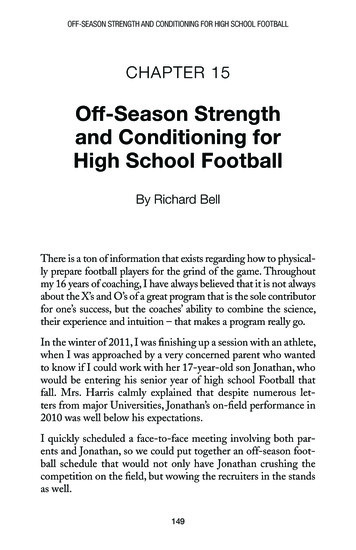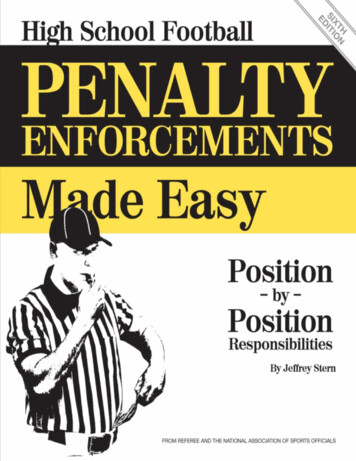
Transcription
High School Football Penalty Enforcements Made Easy:Position By Position Responsibilities — Sixth EditionBy Jeffrey Stern, senior editor, Referee magazineThe derivative work represented by this book is copyrighted by Referee Enterprises, Inc. ( 2013),which includes the title and graphics, and is used by permission.The illustrations, including the chapter graphics, in this book are protected by copyrights of RefereeEnterprises, Inc. ( 2013) and are used by permission. PlayPic and MechaniGram and theirrelated graphics are registered trademarks of Referee Enterprises, Inc., and are copyrighted.Copying in whole or in part is prohibited without prior written consent from Referee Enterprises, Inc.Republication of all or any part of this publication, including on the Internet, is expressly prohibited.Published by Referee Enterprises, Inc. (www.referee.com) and the National Association of SportsOfficials (www.naso.org)Printed in the United States of AmericaISBN-13: 978-1-58208-217-2
Table of ContentsIntroductionChapter 1Calling a Foul and Using the flagChapter 2Reporting a foulChapter 3Enforcing the PenaltyChapter 4Penalty signaling sequencesChapter 5Spots and the All-but-one PrincipleChapter 6Fouls on running PlaysChapter 7Fouls During a Backward Pass, fumble or legal Forward PassChapter 8Fouls on Free-Kick PlaysChapter 9Fouls on change of Possession playsChapter 10Fouls on scrimmage-Kick PlaysChapter 11Dead-Ball foulsChapter 12Live-Ball Followed by Dead-Ball FoulsChapter 13Double and Multiple FoulsChapter 14Double and Multiple Fouls with change of PossessionChapter 15Carryover Fouls (“Bridges”)Chapter 16TrysAppendix APenalty SummaryAppendix BSignal Chart
IntroductionCalling and enforcing a penalty isn’t as easy as coaches and fans think it is. It takes solid rulesknowledge, great judgment, communication and complete knowledge of the mechanics involved.This book won’t magically give you better judgment, but it willhelp you understand the hows andwhys of the process, from the time the flag is thrownuntil the ball is next snapped or kicked.When a crew messes up any part of a penalty enforcement, the entire crew is to blame. That’s whyHigh School Penalty Enforcements Made Easy isn’t written from an individual perspective. Everyofficial should — make that must — know the procedures.The first five chapters take you through the process. Chapters six through 16 explain the varioustypes of plays on which fouls occur and how they are handled. They are broken up into categories.The idea to place penalty enforcements into slots sprang from the mind of Tom Kelleher, an NFLofficial from 196087. Ed Hochuli, one of the best referees to ever work in the NFL, has refined it.Karl Richins, former collegiate referee and current coordinator of officials for the Big SkyConference, adapted Hochuli’s idea into one for college rules. Richins shared it with Referee, apartnership was born and we decided high school officials would benefit from one too.This book is designed to simplify how penalties are enforced. It is a reference and study tool tohelp you make penalty enforcement second nature.Here’s hoping you find this book as helpful as I have.Jeffrey SternSenior editorReferee magazine
When you observe a live-ball foul, it is crucial that you drop your penalty marker at theproper yardline but withhold the whistle until the play is over. Make a mental note of the spot of thefoul and the number of the offending player but continue to officiate the play; don’t stop at the spot ofthe foul and fail to cover the play to its conclusion.If it is possible the spot of the foul will be the enforcement spot, you must get your flag as close tothat spot as possible. If you’re off target, you should relocate the flag as soon as possible after theplay by picking it up and moving it definitively. The longer you delay making that correction, the moreit will appear you are manipulating the situation. Also, attempting to kick it to the correct spot givesan underhanded appearance.Correct penalty enforcement can be facilitated if the flag is thrown properly. There are two waysto throw the flag: into the air or carefully to a spot.In PlayPic A, the referee sees a live-ball foul: the offensive lineman holding the pass rusher.Because the penalty may be enforced from the spot of the foul, it is important for the referee to throwhis flag to the yardline on which the infraction was committed. The flag should be thrown so that ithits the ground on either side of the players; don’t think of the player as a dart board and your flag asa dart. Throwing the flag in the direction of the players will help the referee observe the number ofthe offending player. Whether an overhand or underhand motion is used is up to the individual.For dead-ball fouls or fouls simultaneous with the snap, such as a false start or encroachment, thewhistle should be blown immediately and the flag should be tossed into the air directly in front ofyou. In PlayPic B, a defensive player has committed a dead-ball foul by crossing the neutral zone andcontacting a team A player. The flag should be thrown into the air in front of you and the stop-theclock signal given. Again, don’t stop officiating. The offensive lineman could take exception to thepenalty and retaliate. Once you are confident the action has stopped, jog toward the center of the fieldand report the foul to the referee. Don’t signal; the other wing official may well have a different viewor another foul.
For fouls that prevent the snap, throw the flag into the air.It is strongly recommended that an official who throws a flag or sees one on the field use threeshort blasts on the whistle after the ball is dead to bring the flag to the referee’s attention. The whistleshould be accompanied by the stop-the-clock signal.Sometimes the calling official has to leave the spot of the flag to report to the referee. If feasible,another official should stand at the spot to ensure the flag isn’t moved.If two different officials throw flags on the same play, it is important they communicate to see ifthey saw the same foul or have two different fouls.A few techniques to avoid: slam-dunking the flag to the ground; looking angry when you toss it;holding the flag and waving it, instead of throwing it; or throwing it at the fouling player. On late hits,the latter looks confrontational, and worse yet, might hit the player in the face.
Me-Too FlagsAvoid throwing “me-too” flags. That involves having the official closest to the official who threwhis flag also throwing his flag as a means of supporting his partner. The concept is the coach willthink it is an acceptable call because two officials had it. The technique is both unnecessary anddeceptive.While there are some situations in which the coverage will overlap two officials, many playsdictate each official maintain unique coverage. Further, if the two officials were to offer contradictingexplanations of the foul, the crew’s integrity would be severely diminished. Finally, excessive flagswill contribute to an image of a “flag happy” crew.
Fouls must be reported to the press box and both coaches. Additionally, all fouls must becommunicated to all members of the officiating crew as each official has a role in penaltyenforcement.Once the flag is thrown, the official who threw it must ensure both the referee and linesman areaware as soon as possible after the play ends. The linesman will ensure the chains and box are notmoved and the referee will prepare for the steps that follow.The referee’s first step in quality communication is to get an accurate report from the official whothrew the flag. The referee must then move clear of the players, face the press box, stand stationaryand indicate the foul and the offending team using the appropriate signal.Do not signal fouls from your position.When wing officials throw a flag for a dead-ball foul prior to the snap, they should jog slowlytoward the middle of the field to report the foul to the referee. Remember topractice good dead-ball officiating during the jog; if a player has crossed the neutral zone andcontacted an opponent, the contacted opponent may try to retaliate.A technique to avoid is signaling the foul rather than reporting the foul to the referee (PlayPic C).It’s common in the NFL and major college games, but should not be practiced at other levels becauseanother official may have a different foul. For instance, say the line judge throws a flag because ateam B player entered the neutral zone and contacted the left guard but the umpire throws a flagbecause the snapper illegally moved the ball. If the line judge stays on the wing, gives the hands-onhips signal and points to the defense but the penalty is assessed against the offense, the coach of theoffensive team is certain to be upset. Instead of signaling from the wing, in that case the linesman, linejudge and umpire should get together to discuss what each official has seen, then report their decisionto the referee. The wing officials then return to the sidelines to explain to the coaches what occurred.
Keep your hands off each other when discussing a play.Conferences among officials should be kept as brief as possible. When reporting a foul, bethorough but give the referee only the information he needs.If two or more officials need to discuss a call, avoid putting arms around another official’s waistor back (PlayPic D, page 14). It gives the appearance the officials are conspiring or are trying toconvince another official what he should be calling.
Getting the ExplanationSome referees simply want to hear the foul and offender, such as, “No. 49 offense, illegalmotion.” Other referees prefer to be told what the reporting official saw, as in, “No. 49 cut upfieldtoo soon.” It may make sense to use both techniques depending on the experience level of thecrewmate. By getting more detail from newer officials, the referee can ensure there really was a foul.Be careful with movement fouls when the order of occurrence is a prime factor and be especiallycareful if offensive players on the end of line are involved — their movement is not as restricted as itis for the interior linemen who cannot move from a three-point stance.On certain fouls, it is critical that the referee be told the status of the ball when the foul occurredor whether a player involved was an eligible receiver. Of course the guilty team must also beidentified. The trend at many levels is to get away from referring to teams by jersey color. Thepregame conference should include a discussion of how to report fouls.
Giving the ExplanationWhen it is obvious to the referee that a penalty will be accepted, the captain need not beconsulted. A good example involves a team A foul that occurs prior to a turnover. Team B willobviously want to decline the penalty and take possession. If a choice needs to be made, all aspectsof the penalty (e.g. an automatic first down, ejection, etc.) should be explained to the captain. Statethe options briefly, but correctly, clearly and courteously. The umpire must listen to the referee’sexplanation to ensure the options are properly offered.The wing official on the sideline of the penalized team should tell the coach the number of theguilty player and explain the foul. The call gains credibility if you say, “Your man in motion cutupfield too soon,” instead of, “There was illegal motion.” The other wing official need only tell thecoach the nature of the foul.Once the referee determines whether the penalty has been accepted or declined, he must informother members of the crew. If the penalty is accepted, the umpire must understand where to walk from- the enforcement spot, how far to walk and which direction to walk. It’s quite embarrassing to havethe penalty enforced against the offended team and having to reverse tracks amid the inevitableprotests.The wing officials must be apprised so they can keep their sideline informed. The wing on theoffending team’s sideline should tell the coach the number of the player who fouled; however, if thecovering official didn’t get the number, he shouldn’t guess or make one up. If a non-existent number isreported, crew credibility is immediately destroyed.
Working with Captains and CoachesWhen the referee and umpire meet with the coaches prior to the game, they should obtain the nameand number of each captain. Communication between officials and captains can affect the flow of thegame. Knowing when and in what depth to talk to captains can avoid unnecessary delay. There aresituations in which it is more realistic to consult the coach rather than the captain. For example: TeamK punts on fourth and seven from its own 35 yardline. Team R is flagged for running into the kicker,which carries a five-yard penalty. Team R makes a fair catch at its own 40 yardline. Team K’s coachmay wish to accept the penalty, bringing up fourth and two, and go for the first down, or decline thepenalty because he is happy with team R’s field position. Ultimately (and realistically) the coach willmake the decision anyway. Rather than explaining the options to the captain, the wing official on thatside of the field should explain the options to the coach and relay the decision to the referee.A similar situation occurs when team K’s free kick goes out of bounds untouched by team R. TeamR has the choice of a rekick after enforcement, taking the ball 25 yards from the spot of the kick ortaking the ball at the spot it went out of bounds. Rather than have the referee (who begins the play atteam R’s goalline), sprint upfield and try to find a captain, the official on team R’s side of the fieldand nearest to team R’s coach can explain the options.A foul by the defense on a try will move the ball to the 1-1/2 yardline. If team A is not consideringgoing for two points, it may very well want to decline the penalty, stick to its normal routine and kickfrom the spot it has practiced a thousand times.When the offense chooses to punt because it is just out of field goal range, teams will oftenintentionally incur a penalty for delay. The strategy is to have five more yards to put the punt out ofbounds deeper in the opponent’s territory and avoid the touchback. Team B may prefer to decline thepenalty and foil the strategy.Those are classic examples of why it is important for every official to know and understandpenalties and enforcements.There are several types of fouls that will always be accepted, thus consultation with the captain isunnecessary: Dead-ball fouls.Since the replay of a down is not in question, the distance is gratis. Remember,however, that some dead-ball fouls that occur after a score may be enforced on the succeedingkickoff. Penalties for unsportsmanlike conduct are enforced as if they are dead-ball fouls and willlikely be accepted. Fouls after a change of possession.Certain fouls during kickoff, punt, interception and fumblereturns are similar to dead-ball fouls in that there is no down to replay. The interests of the game arebest served by immediately walking off those penalties. If there is more than one foul against the sameteam, you can easily figure out which penalty will yield the greatest benefit. Fouls that negate scores, turnovers and first downs. “Add on” or “tack-on” fouls.Examples of live-ball fouls that add yardage to the end of a playinclude a defensive facemask foul on a running play and roughing the passer on a completed pass. Loss of down/automatic first down.It would be most unusual for a team not to want a penaltythat carries loss of down or an automatic first down. There are many other situations in whichacceptance of the penalty is obvious, such as a dead-ball personal foul.
Declination of a penalty can also be an obvious choice. When a play results in a first down andthe penalty would not, you can signal the refusal without discussion.
If the penalty has previous-spot enforcement, the umpire must return not only to the yardline atwhich the ball was last snapped, he must also go back to the spot between the hashes (the lateralposition of the ball).In MechaniGram E, team s snapping from the hashmark on its own 20 yardlme. In MechaniGramF, A2 is flagged for illegal motion as A1 completes a pass to A3 closer to the opposite hash. A3 isimmediately tackled by B4.When team B accepts the penalty, the umpire must return to the exact place from which the playstarted —that is, the same hashmark on team A’s 20 yardline — and the penalty enforced from there(MechaniGram G).The umpire should avoid “marching off the penalty” a yard a time. It looks far more professionalto calculate the distance from the enforcement spot and go directly to the proper yardline. Forinstance: Team A is to be penalized for holding.The spot of enforcement is team A’s 37 yardline. The umpire should move briskly and directly toteam A’s 27 yardline and place the ball.The linesman must be certain of the down number. Don’t forget that acceptance of a penalty that
includes loss of down or declination of a penalty will not result in a replay of the previous down.As a backup to ensure the umpire has properly enforced the penalty, the linesman should proceedto the succeeding spot. Once the penalty is enforced, the linesman should have the down box, the lineto-gain equipment or both moved. As seen in PlayPic H, the line judge has flagged team A for a fiveyard, dead-ball foul. As the referee is signaling the foul, the linesman moves to the succeeding spot.The umpire should still calculate where the ball should be placed and take it to that spot, but if thepenalty is enforced correctly, that spot will be where the linesman has already placed himself. Inorder to use the mechanic properly, the linesman must obtain the penalty information from the refereeand umpire.The linesman goes to the succeeding spot as the referee signals.The linesman can then report the foul to the head coach on his side of the field before moving to thesucceeding spot. In the pregame meeting with the chain crew, the linesman must emphasize that thechains should not be moved until the linesman signals them to do so. That prevents a premature orincorrect movement of the box and chains. The line judge should stand at the enforcement spot untilthe ball is marked ready for play.Notice the line judge has not moved off the previous line of scrimmage. That is a good back up incase the chains move incorrectly or prematurely.From the time the whistle blows to prevent the snap or indicate the ball is dead until the refereenext signals the ball is ready, any official not involved in the enforcement process must watch theplayers. If players from both teams are congregating, the back judge in a crew of five may have tomove up toward the line to let players know they should return to their respective sides of the ball.Finally, the referee should again move clear of the players, face the press box, stand stationaryand indicate the foul and the offending team using the appropriate signals.
Many fouls, such as false start, delay of game and encroachment, are self-evident to players,coaches, fans and public address announcers. Those fouls do not require a preliminary signal and thenanother signal after enforcement.Just as officials should avoid making calls on the run, referees should avoid “walking through”their penalty signals. Walking through means failing to come to a complete stop before signaling, asseen in PlayPic I.Referees should avoid “walking through” their signals.To give the signal to the press box, keep your head up. Pick out a spot about halfway up the standsand focus your eyes on that spot. You should have no facial expression; you’re neither happy norunhappy to be performing the task.Give the signal and point to the offending team. Avoid jabbing the arm when signaling; it isanother sign you are angry or feel a sense of “gotcha” toward the offending team.Referees should avoid the habit of striving to get between the hashes to signal every penalty. If aplay ends in a side zone, you only need to be clear of players in order to signal a penalty.
Remind the referee to start the clock on the ready (left) or snap.Once the referee ensures all officials, the box and chains are in their proper places, he can givethe ready signal.The referee has a lot on his mind when enforcing a penalty. The line judge can help by remindingthe referee when the clock should start. After the referee has signaled the press box, he need onlyglance at the line judge to see if the wing official is rotating his index finger (PlayPic J, page 24),which indicates the clock starts on the ready, or snapping his fingers (PlayPic K, page 24), whichindicates the clock starts on the snap. Many crews have adopted other signals; the important thing isthat the information is conveyed. It is suggested that the line judge perform that duty since the refereeis already facing the line judge to signal the press box.
Unsportsmanlike Fouls and EjectionsFor all unsportsmanlike fouls, all officials should record the player’s number or the coach’sposition (i.e. head coach, offensive coordinator, etc.). Remember that a second unsportsmanlike foulagainst the same individual results in his ejection, but a flagrant foul (personal or unsportsmanlike)results in immediate ejection.Only the referee should use the ejection signal, and only when signaling the penalty to the pressbox. Use the approved signal, not a baseball-style windup and throw.If the penalty for a foul includes ejecting the offender, the official who called the foul must informthe offending player. The official should report the player’s number and the type of infraction toreferee, coach and other members of the officiating crew. Keep in mind the coach will likely want amore detailed description than of a more routine foul.All officials should record the ejected player’s number and the time of the ejection. The callingofficial may want to write a brief description of the incident on his game card or a separate card inorder to properly report the incident to the state association or similar authority.Tape on the chain helps determine if team A has less than five yards for a first down.Remember that if a coach is ejected, he must leave the stadium area before the game may resumeand the coach may not have further contact with his team for the remainder of the game includinghalftime. Ejected players are not required to leave the field.
Helping the RefereeCrews can expedite penalty enforcement and avoid unnecessary measurements throughcommunication between the referee and linesman.The linesman indicating “five will get you one.”In PlayPic L, the down box is farther downfield than the tape used to indicate the halfway point onthe chain. That means a five-yard penalty on team B will result in a first down for team A, or as oftenabbreviated by crews, “Five will get you one.”The linesman can indicate the situation by making eye contact with the referee and placing thepalm of his hand flat against his chest (PlayPic M, page 26). If a team B foul such as encroachmentoccurs, the referee already knows that a new series will be awarded.Note:The chain and box are not shown in the proper place two yards outside the sideline in orderto better illustrate the point.One of the hazards of being a wing official is being the target of angry coaches, even when thewing official hasn’t made the call in question. Brisk and businesslike penalty administration will getthe ball in play more quickly, thus diverting the attention of the angry coaches. If the referee has madethe call, the wing official can help the referee simply by standing near the flag.In PlayPic N (on page 28), the quarterback, having been flushed from the pocket by a hardcharging defender, was roughed after releasing the pass. The referee has properly followed the flowof the play toward team B’s sideline and is in position to flag the foul while the wing official isobserving players downfield.Because the foul occurred in front of team B’s bench, the sideline may well erupt in anger. It istempting for the referee to remain in front of the bench and argue or try to explain the call. A betterprocedure is for the wing official (in this case, the linesman) to come back to the spot of the flag andmark the spot while the referee gives the preliminary signal (PlayPic O) and works with the umpire toenforce the penalty.The wing official on the opposite side of the field (in this case, the line judge) should casuallywalk off the penalty to serve as a backup for the umpire. The umpire and line judge should wind up at
the same spot; if not, the proper spot should be determined before the umpire places the ball on theground and the chains set at the new spot. If done properly, the line judge will be mirroring theumpire’s spot.If the referee has a foul near the fouling team’s side-line (above), the wing official can standover the flag while the referee can move farther away from any angry coaches.Once the penalty has been enforced and the ball properly spotted, the linesman should pick up theflag, jog to the middle of the field and toss or hand the flag back to the referee (PlayPic P, page 29).
“Eting” a FlagEvery official has made a call he would like to have back. Thus, the timeless advice, “When indoubt, don’t throw the flag,” or, “If you see a foul, flag it, but if you only think it’s a foul, don’t.”By returning the flag to the referee in the middle of the field, the wing official can keep thereferee away from the sideline.In addition to officials occasionally asking each other for help, a “change of heart” flag can occuronce in a while as well. Although those are difficult to explain to coaches, it’s unfair to penalize ateam when the covering official suddenly realizes he isn’t sure a foul occurred.If you feel you’ve thrown an erroneous flag, explain the situation the referee. Both coaches willwant to know what’s going on. But only the referee should “wave off the flag” as seen in PlayPic Q.Only the referee should give the signal for ignoring the flag.
The order of the penalty signals used by the referee is just as important as the clarity of thesignals. Think of signal sequence as words in a sentence. The singular words, “Sequence importantthe is the of signals,” makes little sense when thought of as individual words. But “The sequence ofthe signals is important,” uses the same words and is easy to understand.The key to quality signaling is remembering that it is a sequence of fluid movements. Take yourtime. Signals executed with separate and distinct motions ensure clarity; jumbled quickly together andthe messages are lost. Also, remember to wait for the linesman to indicate the chains are in positionand the rest of the crew is ready before giving the ready-for-play.It is also important to face the proper direction when giving the signal. All signals are givenfacing the press box.The ready-for-play signal can be the downward stroke of your arm for the start-the-clock signalwhen the clock starts on the ready.
Signaling Live-ball FoulsSignaling the penalty for a run-of-the-mill live-ball foul is a four-step process: foul signal, a pointtoward the team that fouled, an indication of the next down and either the ready-for-play or start-theclock signal. Other signals, such as loss of down or an ejection signal, may need to be added. But inmost cases, only four signals are needed.One example of a typical penalty signaling sequence involves roughing the passer. As seen inPlayPic R, the referee signals the foul (1), indicates which team has fouled (2) and signals that team Ahas been awarded a new series (3). The referee waits to be sure the chains have been moved and theother officials are in position. If the pass was complete and the runner was downed inbounds, thereferee blows his whistle and simultaneously gives the start-the-clock signal (4). If the pass wasincomplete or the play ended out of bounds, the referee gives the ready-for-play while simultaneouslyblowing his whistle (5).Say team B has been called for roughing the passer but team A scored a touchdown. The scoringteam may choose to have the penalty enforced on the try. If so, the sequence in PlayPic S is used withthe ready signal. If the scoring team chooses to have the penalty enforced on the next kickoff, thereferee signals the foul (1) and indicates which team has fouled (2). The referee signals thetouchdown, then points to the spot of the next kickoff to indicate the enforcement (4).In PlayPic T on page 33, the defense has been called for holding. The referee first indicates thefoul (1), followed by the fouling team (2). If the penalty results in a first down, the referee signals thatteam A has been awarded a new series (3). If the runner was downed inbounds, the referee blows hiswhistle and simultaneously gives the start-the-clock signal (4). For an incomplete pass or if the playended out of bounds, the referee gives the ready-for-play while simultaneously blowing his whistle(5).
Cases that involve an ejection add a step to the process. The referee must indicate the decision tothe press box. PlayPic U illustrates the sequence for a live-ball foul for illegal helmet contact thatresults in an ejection. The referee first indicates the nature of the foul (1) and the fouling team (2).The ejection is then indicated (3). If the penalty results in a first down, the referee signals that team Ahas been awarded a new series (4); if not, the referee signals the next down. In this example, thepenalty has given team A sufficient yardage for a first down. If the previous play ended inbounds, thereferee blows his whistle and simultaneously gives the start-the-clock signal (5). If the previous playwas an incomplete forward pass or if the play ended out of bounds, the referee gives the ready-forplay while simultaneously blowing his whistle (6).
Signaling Dead-ball FoulsWhen a dead-b
If a choice needs to be made, all aspects of the penalty (e.g. an automatic first down, ejection, etc.) should be explained to the captain. State the options briefly, but correctly, clearly and courteously. The umpire must listen to the referee’s explanation to
